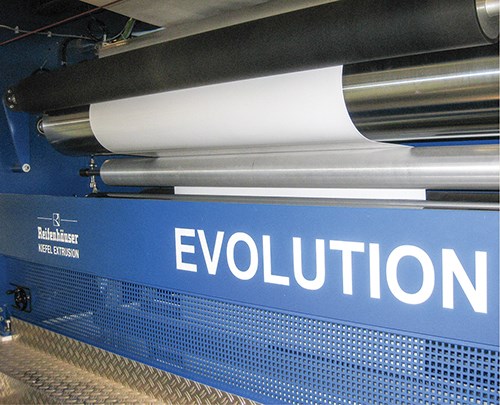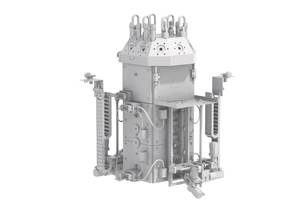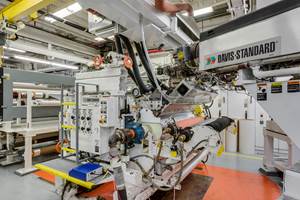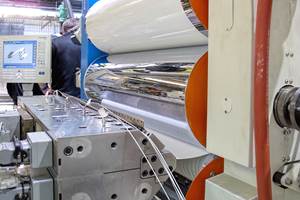Reifenhauser to Unwrap New Extruder, Other Innovations
New machine and novel approaches in blown/cast film, sheet, and wood composites touted.
Reifenhauser gave the global plastics press a first look last month at what it will introduce at
the upcoming K 2013 show, Oct. 16-23, in Dusseldorf, Germany. Among the new entries is what’s described as a new concept in extruders.
Reifenhauser, based in Troisdorf, Germany (U.S. headquarters in Wichita, Kan.), also unveiled a collection of innovations to make film and sheet processors more efficient and flexible. They included patented technology that promises flatter films, a concept that could permit cast film to be produced with properties more akin to blown film, and developments in cast-film contact rolls and cooling stacks for sheet.
The novel extruder line has been dubbed the Evolution series. While most details about it will remain under wraps until show time, the extruder will feature an Energizer screw that “will avoid useless energy input, reduce energy consumption, and lower melt temperature by as much as 20° C (68° F) without compromising melt quality or output,” notes Ulrich Reifenhauser, the company’s managing director.
In fact, he adds, the lower melt temperatures made possible by the new screw could allow processors to ramp up output, if necessary.
The extruders, which will be available in 30 to 150 mm diam. with 30:1 L/D, require virtually no barrel cooling. Reifenhauser has devised a “smart air-management system” that diverts hot air from the extruder to the hopper to preheat the material. The extruders will also feature new drive technology that will allow processors more flexibility to select motor type and motor-cooling method.
FLATTER BLOWN FILM
In blown film, the company’s Reifenhauser Kiefel unit will display new technology that promises to yield flatter blown film, a critical consideration in high-speed converting operations. Historically, so-called film-flattening units were placed just in front of the winder.
The Evolution Ultra Flat unit, however, is installed between the haul-off nip-roll assembly and turner-bar system, which Reifenhauser says is an ideal place for stretching and flattening because the film is still warm and more malleable.
Stretch ratios on the unit are adjusted by heating and cooling rolls with independently controlled speed and temperature. This allows processor to make adjustments for the required film properties and to counteract sagging of the web. The end result is faster and easier conversion at high speed with less waste, company officials say.
Reifenhauser is also developing technology that will integrate machine-direction orientation (MDO) into the Evolution unit, perhaps eliminating the need for separate MDO equipment.
The Evolution Ultra Flat can be retrofitted to most existing lines and is currently being beta tested by two stretch-film processors, Ulrich Reifenhauser reports.
In cast film, the firm has engineered a device to stretch the material in the cross, or transverse, direction. “The idea behind this concept is to allow processors to produce cast films with properties that mimic blown film, in that machine- and cross-directional properties are more balanced,” says Ulrich Reifenhauser. A prototype of the machine is currently in the company’s lab in Troisdorf. While the firm would not divulge the precise mechanical means used to stretch the film, it noted that the new technology would add only 3 ft to the line’s length.
The machine builder also has developed a new contact roll for its line of Midex rotary-arm cast-film winders. This retrofittable contact roll has a proprietary micro-structure and soft rubber coating that reportedly improve web contact and reduce the chance the film will block during winding. This is said to eliminate the need for rewinding the film in many cases. It also reportedly allows processors to cut down on usage of anti-block additives while eliminating the need for electrostatic charging of the film, which is typically used to improve winding quality.
HIGH-PERFORMANCE SHEET STACK
Meantime, Reifenhauser will also debut at K 2013 the Mirex MT polishing-stack technology. The patent-pending unit allows for automatic, digital nip adjustment, even during production runs, eliminating the need for manual, trial-and-error nip adjustments that require the line be stopped. With no hydraulics, the Mirex MT is suited for clean rooms, the company says.
The angular position of the first polishing roll can be varied by 30° using an X-Y adjusting device. Individual drives arranged on both sides of the roll facilitate axle crossing of the first two rolls—necessary for a uniform film-thickness profile.
The Mirex MT is available in three designs, depending on application, film thickness, and production capacity.
LOWER COST WPC TECHNOLOGY
At K 2013, Reifenhauser will also debut a new wood-polymer composite (WPC) decking system. Called Reiwood, the system combines new profile and die-head designs said to permit procssing at costs 50% below the current market standard. For wooden decking or facia cladding, the technology is also said to provide significant advantages when mounting.
Cost reductions are achieved primarily from the design of the visible profile: The new geometry alone allowed developers at Reifenhauser to lower material usage by 20%. The new die-head design is also said to enable significantly higher production speeds. During the show the line with be running at Reifenhauser’s tech center in Troisdorf.
Related Content
Davis-Standard to be Systems Integrator for Novel EDI Flat Die
Die uses motorized lip-adjustment, said to be three to five times faster than heated-bolt adjustments.
Read MoreGreen’s the Theme in Extrusion/Compounding
The drive toward circular economy is requiring processors to make more use of PCR. Machine builders at K—across all extrusion processes—will be highlighting innovations to help them do just that.
Read MoreRoll Cooling: Understand the Three Heat-Transfer Processes
Designing cooling rolls is complex, tedious and requires a lot of inputs. Getting it wrong may have a dramatic impact on productivity.
Read MoreRead Next
How Polymer Melts in Single-Screw Extruders
Understanding how polymer melts in a single-screw extruder could help you optimize your screw design to eliminate defect-causing solid polymer fragments.
Read MoreUnderstanding Melting in Single-Screw Extruders
You can better visualize the melting process by “flipping” the observation point so that the barrel appears to be turning clockwise around a stationary screw.
Read MoreAdvanced Recycling: Beyond Pyrolysis
Consumer-product brand owners increasingly see advanced chemical recycling as a necessary complement to mechanical recycling if they are to meet ambitious goals for a circular economy in the next decade. Dozens of technology providers are developing new technologies to overcome the limitations of existing pyrolysis methods and to commercialize various alternative approaches to chemical recycling of plastics.
Read More





























